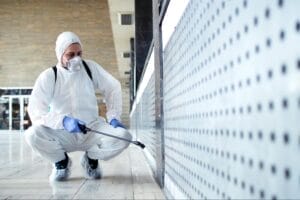After experiencing water damage in your home, prompt mold inspection is crucial to prevent further issues. Mold can grow rapidly, especially in moist or poorly ventilated areas. Use these methods to detect mold:
Effective Ways to Check for Mold After Water Damage
1. Trust Your Sense of Smell: One of the first indicators of mold growth is its distinctive musty odor. If you detect a musty smell in any area of your home, especially after recent water damage, mold is likely present. Follow your nose to pinpoint areas that require closer inspection.
2. Identify Mold on Walls: Inspect all walls thoroughly, particularly in areas that were exposed to water or moisture. Look for discoloration, dark spots, or patches of mold growth. Mold on walls often appears as black, green, or gray spots and can sometimes be fuzzy or slimy in texture.
3. Walk Barefoot on Carpets: Carpeted areas affected by water damage are prone to mold growth, especially if not dried thoroughly. Walk barefoot on carpets and feel for any dampness or sponginess. Musty odors emanating from carpets can also indicate hidden mold underneath.
4. Look for Mold on Ceilings: Check ceilings for any signs of water stains, discoloration, or mold growth. Ceilings are susceptible to mold if there are leaks from the roof or plumbing fixtures above. Inspect closely around light fixtures and ventilation openings where condensation can accumulate.
5. Double-Check Plumbing Repairs: Areas that have undergone recent plumbing repairs are vulnerable to mold growth if not properly dried and sealed. Inspect around sinks, toilets, and other plumbing fixtures for any signs of water damage or mold growth.
6. Inspect the Basement: Basements are often the first areas to experience water damage and subsequent mold growth due to their underground location and susceptibility to flooding. Check corners, walls, and behind stored items for any signs of dampness, water stains, or visible mold.
7. Shine a Light in Dark Corners: Use a flashlight to inspect dark and hidden areas such as behind furniture, in closets, and under sinks. Mold can thrive in poorly lit areas where moisture levels are higher, so thorough inspection with adequate lighting is essential.

What to Do When You Discover Mold
Upon discovering mold in your home, it’s crucial to take immediate action to prevent its spread and address the underlying moisture issue:
- Clean Moldy Surfaces: Use appropriate cleaners or solutions to remove mold from affected surfaces. Wear protective gear such as gloves and a mask to avoid exposure to mold spores.
- Fix Water Leaks: Identify and repair any sources of water leaks or moisture intrusion that contributed to mold growth. Ensure that affected areas are thoroughly dried to prevent mold from returning.
- Consider Mold Prevention Sprays: Apply mold prevention sprays or treatments on cleaned surfaces to inhibit future mold growth. Products like Concrobium Mold Control are effective in creating a protective barrier against mold.
- Monitor for Recurrence: Regularly inspect previously affected areas for any signs of mold recurrence. Address any new water leaks or moisture issues promptly to prevent mold from re-establishing.
How to Prevent Future Mold
Implementing proactive measures can significantly reduce the risk of mold growth in your home:
- Maintain Proper Ventilation: Ensure adequate ventilation in bathrooms, kitchens, and other moisture-prone areas to reduce humidity levels.
- Control Indoor Humidity: Keep indoor humidity levels below 60% to discourage mold growth. Use dehumidifiers in damp areas if necessary.
- Address Water Intrusion Promptly: Repair roof leaks, plumbing issues, and foundation cracks promptly to prevent water damage that can lead to mold.
- Use Mold-Resistant Materials: Choose building materials and furnishings that are mold-resistant, especially in areas prone to moisture such as bathrooms and basements.
- Regular Maintenance: Conduct regular inspections of your home’s exterior, roof, and plumbing systems to identify and address potential water damage issues before they escalate.
Do You Have to Disclose Mold Remediation When Selling a House?
When selling a house, sellers are often required by law to disclose any history of mold remediation or existing mold problems. Proper disclosure ensures transparency and protects buyers from potential health hazards and property damage associated with mold. Learn more about mold disclosure requirements when selling a house and how they may affect your home sale process.




